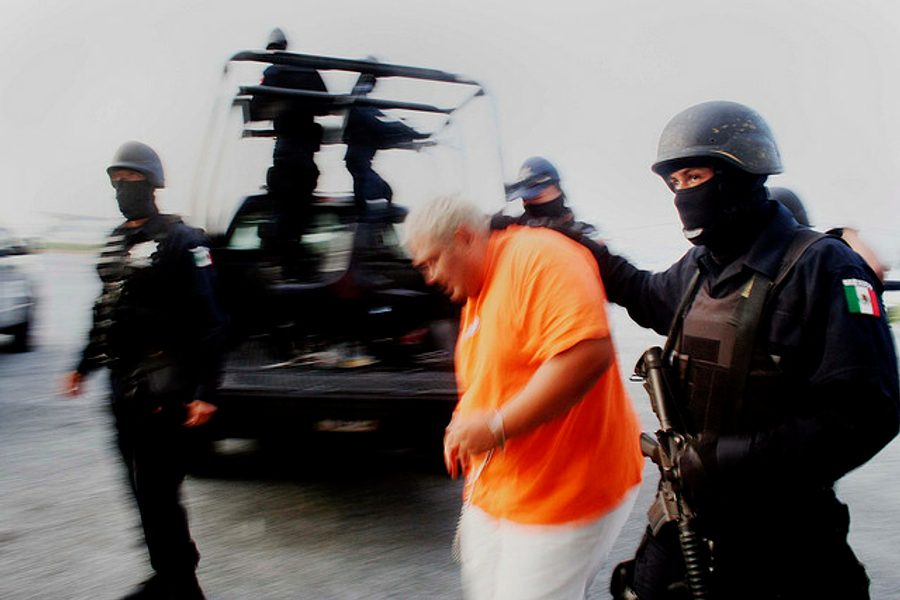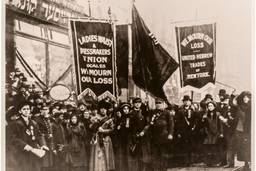When the War on Drugs in Mexico Comes Back Home to the U.S.
Like the Islamic State, the Mexican drug cartels’ power has increased as the result of disastrous U.S. policies.
Rebecca Gordon

First published at TomDispatch.
They behead people by the hundreds. They heap headless, handless bodies along roadsides as warnings to those who would resist their power. They have penetrated the local, state, and national governments and control entire sections of the country. They provide employment and services to an impoverished public, which distrusts their actual government with its bitter record of corruption, repression, and torture. They seduce young people from several countries, including the United States, into their murderous activities.
Is this a description of the heinous practices of the Islamic State (IS) in Iraq and Syria? It could be, but as a matter of fact it’s not. These particular thugs exist a lot closer to home. They are part of the multi-billion-dollar industry known as the drug cartels of Mexico. Like the Islamic State, the cartels’ power has increased as the result of disastrous policies born in the U.S.A.
There are other parallels between IS and groups like Mexico’s Zetas and its Sinaloa cartel. Just as the U.S. wars in Afghanistan, Iraq, and Libya fertilized the field for IS, another U.S. war, the so-called War on Drugs, opened new horizons for the drug cartels. Just as Washington has worked hand-in-hand with and also behind the backs of corrupt rulers in Central Asia, the Middle East, and North Africa, so it has done with the Mexican government. Both kinds of war have resulted in blowback — violent consequences felt in our own cities, whether at the finish line of the Boston Marathon or in communities of color across the country.
In Mexico, the U.S. military is directly involved in the War on Drugs. In this country, that “war” has provided the pretext for the militarization of local police forces and increased routine surveillance of ordinary people going about their ordinary lives.
And just as both the national security state and the right wing have used the specter of IS to create an atmosphere of panic and hysteria in this country, so both have used the drug cartels’ grotesque theater of violence to justify their demonization of immigrants from Latin America and the massive militarization of America’s borderlands.
The War in Mexico
If there was an official beginning to Mexico’s war on drugs, it would have to be considered the election of Felipe Calderón as the country’s president in 2006. The candidate of the right-wing Partido Acción Nacional, the National Action Party (PAN), Calderón was only the second Mexican president in 70 years who did not come from the Partido Revolucionario Institucional, the Institutional Revolutionary Party (PRI). His predecessor, Vicente Fox, had been the first.
It was Calderón who, with encouragement and assistance from the United States, changed Mexico’s war on drugs from a metaphor into the real thing, in which guns and grenades would fuel the deaths of more than 60,000 Mexicans through 2012.
The current president, Enrique Peña Nieto of the PRI, admits that another 27,000 Mexicans were murdered in the first year of his presidency. At least another 25,000 have been disappeared since 2007. It was Calderón who brought the Mexican military fully into the fight against drugs, transforming an ineffective policing policy into a full-scale shooting war with the cartels. At least 50,000 military personnel have been deployed.
In addition to ordinary citizens, journalists and politicians have been particular targets in this war. The Committee to Protect Journalists reports that murders of Mexican reporters have increased dramatically since 2006. Among those whose killers have been positively identified, 69% died at the hands of the drug cartels, and at least 22% were killed by government or military personnel.
Wikipedia lists over 100 politicians who have lost their lives in Mexico’s war on drugs. That list does not include a woman named Aide Nava González, whose headless body was dumped this month on a road in Guerrero state. Nava was contending for the Partido Revolución Democrática, the Democratic Revolution Party, slot on the ballot in the town of Ahuacuotzingo. Her husband, the former mayor, had been murdered there last year. A note from Los Rojos, a local drug gang, was left with Nava’s body. “This is what will happen,” it read, “to anyone who does not fall in line, fucking turncoats.”
Guerrero is the home of Ayotzinapa, a town where 43 teachers-in-training once attended a rural teachers college. All 43 “disappeared” last September during a demonstration in the neighboring town of Iguala. Their arrest by police, and apparent subsequent murder at the hands of a local drug gang, Guerreros Unidos, was one of the few stories of Mexican suffering to break into the U.S. mainstream media last year. The mayor of Iguala has since admitted that he instructed the police to hand the students over to the gang and has been arrested, along with his wife. The town’s police chief is still on the run.
Like the “war on terror” globally, Mexico’s war on drugs has created endless new pretexts for government repression, which has its own lengthy history in that country. That history includes the long-remembered police murders of some 300 students, among the thousands protesting in Mexico City’s Plaza de las Tres Culturas a couple of weeks before the Summer Olympics began in 1968. Juan Méndez, the U.N.‘s Special Rapporteur on Torture, wrote in his 2014 mission report on Mexico:
“The National Human Rights Commission recorded an increase in the number of complaints of torture and ill-treatment since 2007 and reported a peak of 2,020 complaints in 2011 and 2,113 in 2012, compared with an annual average of 320 in the six years prior to 2007. Between December 2012 and July 2014, the Commission received 1,148 complaints of violations attributable to the armed forces alone.”
According to Méndez, it’s difficult to pinpoint the exact number of torture cases in the country in any year, because there is no national registry that records such complaints. Nor is everyone who was tortured by representatives of the government likely to report their suffering to that same government.
What is not difficult to pinpoint is the nature of the torture. Méndez notes the “disturbing similarities” in the complaints of those tortured. The police and the military are regularly reported to use a combination of “punches, kicks, and beatings with sticks; electric shocks through the application of electrical devices such as cattle prods to their bodies, usually their genitals; asphyxiation with plastic bags; waterboarding; forced nudity; suspension by their limbs; [and] threats and insults.”
The purpose of such torture is clear as well. As Mendez reports, it’s “to punish and to extract confessions or incriminating information.” A 2008 change to the Mexican constitution makes it easier to do this: under this policy of pre-trial detention (arraigo in Spanish), suspected drug traffickers can be held for up to 80 days without charge. According to the Mexican Commission for the Defense and Promotion of Human Rights, “Supposedly,arraigo is used as a means to investigate suspected criminals, but in practice, it is used as a kind of public scrutiny that allows more time for the authorities to determine whether the detained is guilty or innocent.” It’s much easier to extract a confession when you have electric cattle prods and waterboarding at your disposal.
Washington Fights a “War” in Mexico
Who pays for Mexico’s war on drugs? You won’t perhaps be too surprised to learn that the United States foots a major part of the bill. Between 2008 and 2014, Congress has appropriated $2.4 billion dollars to fight the cartels, as part of the Mérida Initiative, a “security cooperation agreement” between the U.S. and Mexican governments. That money supports a failed war in which tens of thousands have been killed and thousands more tortured.
U.S. involvement, however, goes far beyond money. Along with the publicly acknowledged Mérida Initiative, the Justice Department and the Drug Enforcement Administration (DEA) signed secret agreements with the Fox and Calderón administrations without the knowledge or consent of the Mexican congress. These openly violated the Mexican constitution, which reserves to that congress the right to approve agreements with foreign governments, as well as the U.N. Convention Against Transnational Crime, which requires that activities carried out by one country inside another be approved by the appropriate agency in the country where those activities take place.
Under these secret agreements, U.S. DEA agents met repeatedly with high-level members of particular drug cartels, especially the Sinaloa group, to obtain information about rival organizations. Informants served as go-betweens in contacts between the DEA and “El Chapo” Guzmán, the head of that cartel. Guzmán was arrested in 2014 by the Mexican government. The newspaper El Universal conducted a year-long investigation in which its reporters documented the extent and effects of this illegal cooperation. The DEA arranged to dismiss drug trafficking charges that were pending in the United States against some of their Sinoloa Cartel informants. In other words, it allowed the cartels with which it worked to continue business — and murder — as usual.
In at least one case, U.S. Immigration and Customs Enforcement (ICE) issued multiple re-entry visas to informants, allowing them to bring significant quantities of drugs into the United States with impunity. In fact, it appears that, in order to maintain the flow of information, U.S. officials took sides in the drug war that devastated the Mexican city of Ciudad Juárez, killing an estimated 10,500 people. With tacit U.S. permission, the Sinaloa Cartel was able to defeat the rival Juárez Cartel.
Seventy percent of the guns used in Mexico’s drug wars also come from this country. Most are purchased at one or another of the 6,700 licensed firearms sales outlets along the U.S.-Mexico border. The University of San Diego’s Trans-Border Institute estimates that, between 2010 and 2012, about 253,000 firearms were bought each year for transfer to Mexico. And most of them made it across the border. The Institute reports that “Mexican authorities have seized roughly 12.7% of the total annual trade” in weapons. U.S. interdiction efforts account for a measly 2% of those seized.
And not all of the weapons that ended up in Mexico did so against the wishes of the U.S. government. In the debacle known as “Fast and Furious,” the Bureau of Alcohol, Tobacco, Firearms, and Explosives (ATF) allowed “more than 2,000 weapons, including hundreds of AK-47-type semi-automatic rifles and .50 caliber rifles,” to “walk” across the border and into the hands of the Mexican cartels. Its ostensible purpose was to follow the guns in hopes that they would lead to the arrest of high-level cartel leaders. But relevant agencies of the Mexican government were never informed about the operation, and it seems that there was no actual effort to track the weapons once they crossed the Mexican border. The weapons turned up at crime scenes in both Mexico and the United States. On December 14, 2010, near the Mexican border in Arizona, one of them killed Brian Terry, a U.S. Border Patrol agent.
ATF wasn’t the only agency involved in “Fast and Furious.” Personnel from ICE, the Department of Homeland Security, the DEA, and the U.S. Attorney’s Office in Arizona also participated, along with the FBI and the IRS.
Nor was the Mexican government entirely informed, although it seems clear that one man, Eduardo Medina Mora, knew about it. A former director of Mexico’s equivalent of the CIA, Medina is considered the “legal architect” of that country’s drug war. He was Mexico’s attorney general when Fast and Furious got underway. By 2010, he’d been removed from that post (possibly because one of his top deputies was arrested for taking bribes from the cartels) and appointed ambassador to the United Kingdom. Later, he served as ambassador to the U.S. until, in early March 2015, President Peña Nieto barely won Senate approval of Medina’s appointment to a 15-year term as head of Mexico’s Supreme Court. Mexicans who still remember Fast and Furious were outraged.
The Pentagon and CIA are also involved in Mexico in significant ways. Since at least 2011, the Pentagon has deployed both piloted aircraft and drones in the Mexican war on drugs. The CIA has also sent operatives to do intelligence gathering. And without specifying which agencies are responsible for such activities, the New York Times reports that “the United States has trained nearly 4,500 new [Mexican] federal police agents and assisted in conducting wiretaps, running informants, and interrogating suspects.” Furthermore, the “Pentagon has provided sophisticated equipment, including Black Hawk helicopters.”
In 2011, the State Department recalled career diplomat Earl Anthony Wayne from Kabul. He was then serving as deputy ambassador to Afghanistan and coordinating with the NATO-led occupation forces there. His new assignment based on his counterinsurgency experience? Ambassador to Mexico. In 2013, the U.S. Army opened a special-ops center in Colorado, according to the El Paso Times, “to teach Mexican security forces how to hunt drug cartels the same way special operations teams hunt al-Qaida.” Because that worked out so well in Afghanistan and Iraq.
The Drug War Comes Home (Along With Plenty of Blowback)
All in all, the U.S. drug war in Mexico has been an abject failure. In spite of high-profile arrests, including in 2014 Joaquín “El Chapo” Guzmán, who ran the Sinaloa group, and in 2015 Servando “La Tuta” Gómez, head of the Knights Templar Cartel in Michoacán, the cartels seem as strong as ever. They may occasionally split and reassemble, but they are still able to move plenty of product, and reap at least $20 billion a year in sales in the United States. In fact, this country remains the world’s premier market for illegal drugs.
The cartels are responsible for the majority of the methamphetamine sold in the United States today. Since 2006, when a federal law made it much harder to buy ephedrine and pseudoephedrine in this country, the cartels have replaced small-time U.S.-based meth cookers. The meth they produce is purer than the U.S. product, apparently because it’s made with purer precursor chemicals available from China. The other big product is heroin, whose quickly rising consumption seems to be replacing the demand for cocaine in the United States. On the other hand, marijuana legalization appears to be cutting into the cross-border traffic in that drug.
The Washington Post reports that almost 9% of Americans “age 12 or older — 22.6 million people — are current users of illegal drugs, according to the Substance Abuse and Mental Health Services Administration.” That represents a one-third increase over the 6.2% in 1998. It takes a lot of infrastructure to move that much product.
And that’s where U.S.-based gangs come in. Urban gangs in the United States today are not the Sharks and Jets of West Side Story. Certainly, there are still some small local groups formed by young people looking for family and solidarity on the streets. All too often, however, today’s gangs represent the well-run distribution arm of the international drug trade. In Chicago alone, 100,000 people work in illegal drug distribution, selling mostly into that city’s African-American community. Gang membership is skewing older every year, as gangs transform from local associations to organized, powerfully armed criminal enterprises. Well over half of present gang members are adults now. The communities where they operate live in fear, caught between the gangs that offer them employment while threatening their safety and militarized police forces they do not trust.
Just like U.S. military adventures in the Middle East and Afghanistan, the U.S.-Mexico war on drugs has only left a larger problem in place, while producing blowback here at home. A particularly nasty example is the cartels’ use of serving U.S. military personnel and veterans as hit men here in the United States. But the effects are far bigger than that. The DEA told the Washington Post that Mexican cartels are operating in more than 1,200 U.S. cities. In all those cities, the failed war on drugs has put in prison 2.3 million people — in vastly disproportionate numbers from communities of color — without cutting demand by one single kilo. And yet, though that war has only visibly increased the drug problem in the same way that the war on terror has generated ever more terror organizations, in both cases there’s no evidence that any other course than war is being considered in Washington.

I hope you found this article important. Before you leave, I want to ask you to consider supporting our work with a donation. In These Times needs readers like you to help sustain our mission. We don’t depend on—or want—corporate advertising or deep-pocketed billionaires to fund our journalism. We’re supported by you, the reader, so we can focus on covering the issues that matter most to the progressive movement without fear or compromise.
Our work isn’t hidden behind a paywall because of people like you who support our journalism. We want to keep it that way. If you value the work we do and the movements we cover, please consider donating to In These Times.






